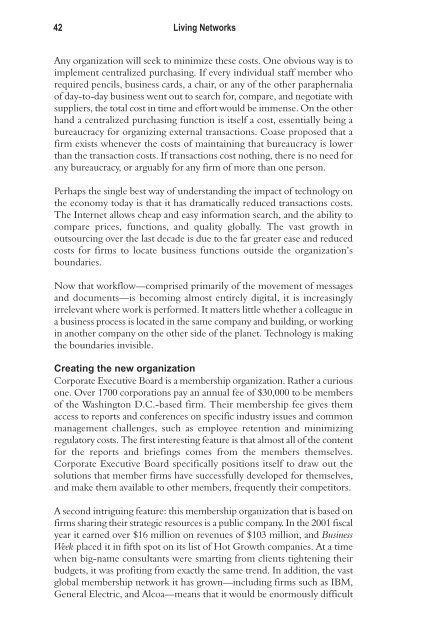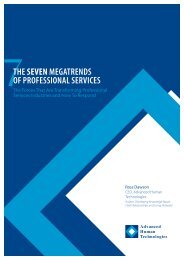Living Networks – Chapter 3: The New Organization - Ross Dawson
Living Networks – Chapter 3: The New Organization - Ross Dawson
Living Networks – Chapter 3: The New Organization - Ross Dawson
Create successful ePaper yourself
Turn your PDF publications into a flip-book with our unique Google optimized e-Paper software.
42 <strong>Living</strong> <strong>Networks</strong><br />
Any organization will seek to minimize these costs. One obvious way is to<br />
implement centralized purchasing. If every individual staff member who<br />
required pencils, business cards, a chair, or any of the other paraphernalia<br />
of day-to-day business went out to search for, compare, and negotiate with<br />
suppliers, the total cost in time and effort would be immense. On the other<br />
hand a centralized purchasing function is itself a cost, essentially being a<br />
bureaucracy for organizing external transactions. Coase proposed that a<br />
firm exists whenever the costs of maintaining that bureaucracy is lower<br />
than the transaction costs. If transactions cost nothing, there is no need for<br />
any bureaucracy, or arguably for any firm of more than one person.<br />
Perhaps the single best way of understanding the impact of technology on<br />
the economy today is that it has dramatically reduced transactions costs.<br />
<strong>The</strong> Internet allows cheap and easy information search, and the ability to<br />
compare prices, functions, and quality globally. <strong>The</strong> vast growth in<br />
outsourcing over the last decade is due to the far greater ease and reduced<br />
costs for firms to locate business functions outside the organization’s<br />
boundaries.<br />
Now that workflow—comprised primarily of the movement of messages<br />
and documents—is becoming almost entirely digital, it is increasingly<br />
irrelevant where work is performed. It matters little whether a colleague in<br />
a business process is located in the same company and building, or working<br />
in another company on the other side of the planet. Technology is making<br />
the boundaries invisible.<br />
Creating the new organization<br />
Corporate Executive Board is a membership organization. Rather a curious<br />
one. Over 1700 corporations pay an annual fee of $30,000 to be members<br />
of the Washington D.C.-based firm. <strong>The</strong>ir membership fee gives them<br />
access to reports and conferences on specific industry issues and common<br />
management challenges, such as employee retention and minimizing<br />
regulatory costs. <strong>The</strong> first interesting feature is that almost all of the content<br />
for the reports and briefings comes from the members themselves.<br />
Corporate Executive Board specifically positions itself to draw out the<br />
solutions that member firms have successfully developed for themselves,<br />
and make them available to other members, frequently their competitors.<br />
A second intriguing feature: this membership organization that is based on<br />
firms sharing their strategic resources is a public company. In the 2001 fiscal<br />
year it earned over $16 million on revenues of $103 million, and Business<br />
Week placed it in fifth spot on its list of Hot Growth companies. At a time<br />
when big-name consultants were smarting from clients tightening their<br />
budgets, it was profiting from exactly the same trend. In addition, the vast<br />
global membership network it has grown—including firms such as IBM,<br />
General Electric, and Alcoa—means that it would be enormously difficult







